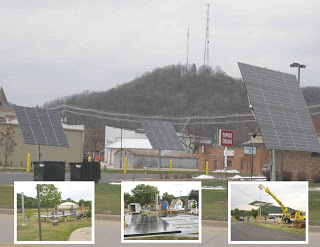
by jboullion | Oct 8, 2010 | Uncategorized
This week, New Glarus Utilities, a member of WPPI Energy, completed a new 5 kW solar project at their wastewater treatment plant located in the village. The energy produced will offset usage at the office building on-site.
by jboullion | Oct 5, 2010 | Uncategorized
From an article by Frank Schultz in the Janesville Press Gazette:
JANESVILLE — So you want to invest.
Stock? Too wobbly.
Interest at the banks? Scant.
A rural Janesville man has found an investment that appears to work in any economy: the sun.
The sun, which is not expected to burn out for billions of years, spills massive amounts of energy onto the Earth every day. It also puts cash into Chuck Niles’ pocket.
Niles, a retired General Motors worker, said he’s been thinking about solar power for 25 years. He got serious about it three years ago when he learned that improvements in solar technology have reduced the cost per watt considerably.
Then he heard about government programs that provide huge discounts in startup costs.
Here’s how Niles does the math:
The 90 panels on the roof of Niles’ pole barn and nearby shed on Murray Road south of Janesville cost $130,410, installation included.
A federal program known as Section 1603 of the Recovery Act paid him $39,600. The state Focus on Energy program paid him $32,603.
Niles uses about $35 worth of electricity a month in the barn. The rest goes to Alliant Energy, which pays him monthly. The checks vary with sunshine, but Niles estimates conservatively that the checks will average around $440 a month.
In the meantime, Niles is also getting a federal income-tax break from the depreciation on his investment.
When all the costs and benefits are accounted for, Niles figures his payback period is just five years. He figures his return on investment is about 12 percent.
by jboullion | Sep 28, 2010 | Uncategorized
Commentary
by Michael Vickerman, RENEW Wisconsin
September 27, 2010
One of the abiding pleasures of my job at RENEW Wisconsin is going out into the field to visit renewable energy installations. Many of the systems sprouting across the state owe their existence to state and federal policies that make these systems economically viable to their owners.
In turn, some of those policies owe their existence to RENEW, an advocacy organization that has elevated the Wisconsin renewable energy marketplace from a dreamy aspiration to a thriving marketplace employing hundreds of people and generating millions of dollars a year in local revenues.
Whenever I’m asked to describe our mission, I often say that we act as a catalyst for advancing a sustainable energy future in Wisconsin. Our vision of that future places small, entrepreneurial companies at the center of the transition toward clean, locally available energy resources that do not deplete over time.
RENEW endeavors to steer Wisconsin along this path through policy mechanisms that help renewable energy businesses establish themselves in an economy that for many decades has operated almost exclusively on fossil energy. Because of that dependence on concentrated energy sources like coal, natural gas and liquid hydrocarbons, which are still priced very cheaply, the shift to renewable energy has been an uphill battle. The incumbent energy sources are well-entrenched and will not hesitate to expend significant political capital to block policy initiatives aimed at putting renewable energy on a more equal playing field. Continued . . .

by jboullion | Sep 24, 2010 | Uncategorized
From the Web site of City Utilities of Richland Center:
Electric customers in Richland Center are benefitting from a new application of solar power in the city. The community-owned utility recently installed an array of solar photovoltaic (PV) panels at City Hall.
City Utilities of Richland Center installed three dual axis trackers with a total output of 8.64 kilowatts, providing approximately 14,500 kilowatt-hours of emissions-free electricity each year.
“It is our objective to be a model for the use of renewable energy,” said Commission President Rod Perry. “By supporting community-wide renewable projects, City Utilities is illustrating the practical use of renewable energy and enticing customers to do the same.”
Solar PV systems collect energy from sunlight and convert it into electricity, providing renewable, emissions-free energy. These highly visible projects demonstrate the technology, while educating the community on their benefits, operation and performance.
City Utilities pursued various grant opportunities, including funding from its power supplier WPPI Energy, to help fund the purchase and installation of the solar PV systems. The project is contracted through H&H Solar Energy of Madison and became operational in September 2008.
“We’re working hard to lead by example,” said Perry. “The use of renewable energy is a simple step anyone can take to help create a cleaner energy future.”
The project
Three 2.88 kW dual-axis trackers
14,220 kWh per year
PV panels: Kyocera KD180
Installed by H & H Solar Energy Services
Output detail
by jboullion | Aug 25, 2010 | Uncategorized
From a article by Tom Content in the Milwaukee Journal Sentinel:
Town of Oconomowoc — Sandy Syburg has driven school buses for years – but none like these.
When they start rolling on their routes next week, these hybrid electric school buses won’t lurch forward the way conventional school buses do.
A diesel engine is least efficient when it’s trying to get a 27,000-pound vehicle moving from a full stop, Syburg said. Thanks to the hybrid technology, the electric motor kicks in first, with lithium-ion batteries powering the bus forward from a stop.
“It’s very smooth. It’s like a gust of wind when you’re sailing,” said Syburg, chief executive of Oconomowoc Transport Co.
In the bus terminal, Syburg can plug an electrical cord into the side of the bus so that solar panels can charge the batteries that run the vehicle’s electric motor.
To date, more than 100 hybrid school and commercial buses have rolled off of the IC Bus LLC assembly line since 2007. Eleven of them are plug-in hybrid electric school buses in Oconomowoc, ready to start the school year next week.
The investment, aided by a state grant through the federal stimulus package, aims to reduce diesel fuel use by 7,500 gallons a year. That would provide savings of $26,000 in fuel costs for the Oconomowoc Area School District at today’s diesel prices.
When they’re done with their morning school run, the buses will return to the bus company on Brown St. and their batteries will be recharged with the help of 224 solar panels that were erected by Renewable Energy Solutions of Waukesha.
It’s the first solar-electric charging station in the state, and it’s ready to power the biggest fleet of plug-in hybrid school buses in the country.
The buses are projected to result in saving because of a 50% gain in fuel economy. A typical bus gets 7 miles per gallon, but the hybrid technology will boost that to 12.
“It’s a little glimpse of the future; it’s very impressive,” said Mike Barry, assistant superintendent of the district. The district will seek to incorporate the solar-powered hybrids into its curriculum.
“We’re trying to make some links between the curriculum that the students learn about in school and the real world,” he said. “When the connection is as immediate as the very bus that takes you to and from school, that’s a powerful connection.”


